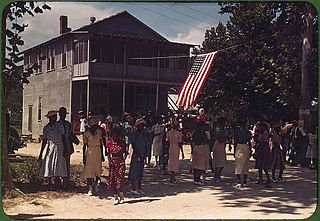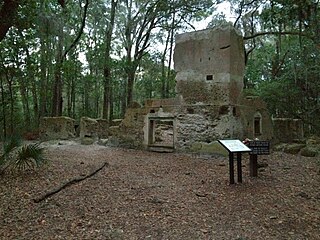Related Research Articles

Hilton Head Island, sometimes referred to as simply Hilton Head, is a Lowcountry resort town and barrier island in Beaufort County, South Carolina, United States. It is 20 miles (32 km) northeast of Savannah, Georgia, and 95 miles (153 km) southwest of Charleston. The island is named after Captain William Hilton, who in 1663 identified a headland near the entrance to Port Royal Sound, which mapmakers named "Hilton's Headland." The island features 12 miles (19 km) of beachfront on the Atlantic Ocean and is a popular vacation destination. In 2004, an estimated 2.25 million visitors infused more than $1.5 billion into the local economy. The year-round population was 37,099 at the 2010 census, although during the peak of summer vacation season the population can swell to 150,000. Over the past decade, the island's population growth rate was 32%. Hilton Head Island is a primary city within the Hilton Head Island-Bluffton-Beaufort metropolitan area, which had an estimated population of 207,413 in 2015.

Fort Macon State Park is a North Carolina state park in Carteret County, North Carolina, in the United States. Located on Bogue Banks near Atlantic Beach, the park opened in 1936. Fort Macon State Park is the second most visited state park in North Carolina, with an annual visitation of 1.3 million, despite being one of the smallest state parks in North Carolina with 424 acres (1.72 km2). Fort Macon was built as part of the Third System of US fortifications, and was preceded by Fort Hampton of the Second System.

St. Helena Island is a Sea Island in Beaufort County, South Carolina, United States. The island is connected to Beaufort by U.S. Highway 21. The island has a land area of about 64 sq mi (170 km2) and a population of 8,763 as of the 2010 census. It is included as part of the Hilton Head Island-Beaufort Micropolitan Area. The island is renowned for its rural Lowcountry character and being a major center of African-American Gullah culture and language. It is considered to be the geographic influence behind the children's television program Gullah Gullah Island.

The Hunting Island Light is located in Hunting Island State Park on Hunting Island near Beaufort, South Carolina. Although no longer used as a functioning lighthouse, the tower is a fixture at the state park and is open to visitors. It was named to the National Register of Historic Places in 1970.

In North Carolina, the Crystal Coast is an 85-mile stretch of coastline that extends from the Cape Lookout National Seashore, which includes 56 miles of protected beaches, southwestward to the New River. The Crystal Coast is a popular area with tourists and second-home owners in the summer.
Fort Frederick Heritage Preserve is a 3-acre (12,000 m2) property located in Port Royal, South Carolina. Situated along the Beaufort River, the preserve contains the remains of Fort Frederick. Also known as Fort Prince Frederick, the tabby fort was built by the British between 1730 and 1734 to defend against a possible attack from the Spanish at St. Augustine, Florida. It was named to the National Register of Historic Places in 1974.

Tabby Manse, also known as Thomas Fuller House, is a building in Beaufort, South Carolina.

Stoney-Baynard Plantation on Hilton Head Island, SC was listed on the National Register of Historic Places in 1994. The listing included one contributing site on 6 acres (2.4 ha).
Chester Field, located in Beaufort County, South Carolina, is one of the nearly two dozen prehistoric shell rings that run from the center coast of South Carolina to the central coast of Georgia. Archaeologists date the pottery that has been found at these sites to be in the second millennium BC, this placing the artifacts among the earliest pottery of North America. The purpose or use of the ring shape is not known. This “address restricted” site was listed in the National Register of Historic Places on October 15, 1970.
Isaac Fripp House Ruins is a historic house ruin and archaeological site located on Saint Helena Island near Frogmore, Beaufort County, South Carolina. The ruins are located at Bay View overlooking the junction of Chowan Creek and the Beaufort River. The two-story, tabby house dates to the early- to mid-19th century. It is associated with Isaac Fripp, a planter of sea island cotton and other staples on St. Helena Island.
Skull Creek is a historic archeological site located at Hilton Head Island, Beaufort County, South Carolina. The site includes two of 20 or more prehistoric Indian shell middens in a ring shape located from the central coast of South Carolina to the central coast of Georgia. It probably dates from early in the second millennium BC, and is likely to contain some of the earliest pottery known in North America. The Skull Creek rings are the only known example of a later ring superimposed over an earlier one.
Green's Shell Enclosure is a historic archeological site located at Hilton Head Island, Beaufort County, South Carolina. The site includes one of 20 or more prehistoric Indian shell middens in a ring shape located from the central coast of South Carolina to the central coast of Georgia. They are believed to date early in the second millennium BC, and they contain some of the earliest pottery known in North America.
Pine Island Plantation Complex is a historic hunting plantation complex and national historic district located on Pine Island near Frogmore, Beaufort County, South Carolina. The district encompasses six contributing buildings and one contributing sites, and is an early-20th century hunting plantation. The main house at Pine Island was built about 1904, and is a two-story frame structure built on an existing tabby foundation. The front façade features a full-width two-story porch. Also on the property are the contributing cottage, a toolshed/doghouse, a barn, a pumphouse, an automobile garage, and causeway.

Callawassie Island is one of hundreds of barrier and sea islands in the southeast corner in the outer coastal plain, making up a portion of Beaufort County, South Carolina.
Auld Mound (38CH41), also known as Yough Hall Plantation Shell Ring, is a historic mound located near Mount Pleasant, Charleston County, South Carolina. It is one of 20 or more prehistoric shell rings located from the central coast of South Carolina to the central coast of Georgia. On average, it measures 174 feet in diameter and stands 2 to 3 feet high. The midden is largely composed of oyster shell.
Buzzard's Island Site is a historic mound located near Mount Pleasant, Charleston County, South Carolina. It is one of 20 or more prehistoric shell rings located from the central coast of South Carolina to the central coast of Georgia. On average, it measures 178 feet in diameter and stands 3 feet high. The midden is largely composed of oyster shell.

Sewee Mound (38CH45), also known as the Old Fort, is a historic mound located near Awendaw, South Carolina. It is one of 20 or more prehistoric shell rings located from the central coast of South Carolina to the central coast of Georgia. On average, it measures 149 feet in diameter and stands 10 feet high. The midden is largely composed of oyster shell. A smaller midden is located nearby.
Hanckel Mound (38CH7) is a historic mound located near Rockville, Charleston County, South Carolina. It is one of 20 or more prehistoric shell rings located from the central coast of South Carolina to the central coast of Georgia. On average, it measures 158 feet in diameter and stands 8 feet high. The midden is largely composed of oyster shell.
Horse Island (38CH14) is a historic mound located near Rockville, Charleston County, South Carolina. It is one of 20 or more prehistoric shell rings located from the central coast of South Carolina to the central coast of Georgia. On average, it measures 156 feet in diameter and stands 4 feet high. The midden is largely composed of oyster shell.

Beaufort County Courthouse is a historic courthouse building located at Washington, Beaufort County, North Carolina. It was built about 1786, as a two-story, square brick building measuring 42 feet by 42 feet. It was later enlarged with a two-by rear extension and square clock tower. It is one of the earliest public buildings in North Carolina.
References
- 1 2 "National Register Information System". National Register of Historic Places . National Park Service. July 9, 2010.
- ↑ "Sea Pines, Beaufort County (Address Restricted)". National Register Properties in South Carolina. South Carolina Department of Archives and History. Retrieved 1 March 2014.
- ↑ E. Thomas Hemmings (August 1970). "Sea Pines" (PDF). National Register of Historic Places nomination. NRHP. Retrieved 1 March 2014.

